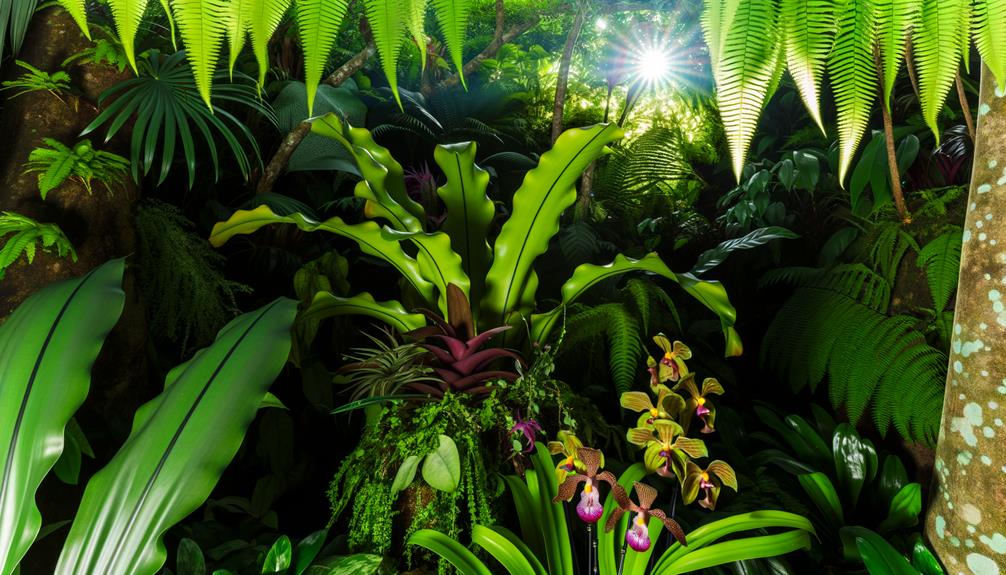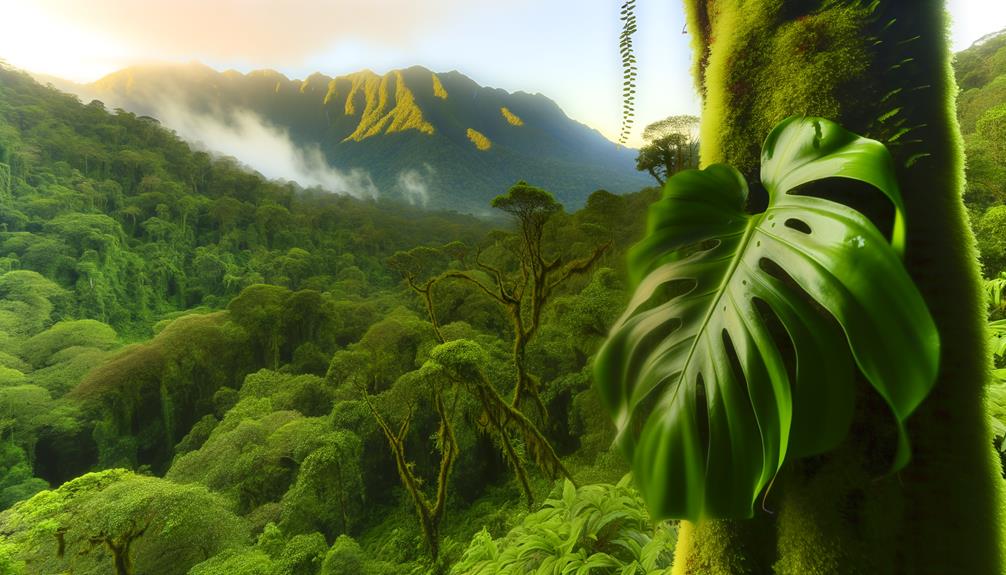Where Does Monstera Epipremnoides Exist in Nature? Discover!
Monstera Epipremnoides exists in the wild in cloud forests at high altitudes, typically between 1300 and 1800 meters, in the mountainous regions of Costa Rica in Central America.
It favors environments near rivers and streams, which provide high humidity and moisture. The region’s consistent temperatures, ranging from 18°C to 27°C, and humidity levels of 60-80% create ideal growth conditions.
This plant flourishes in well-draining, aerated soils rich in organic matter. If you’re intrigued by its natural habitat and adaptive mechanisms, there’s much more to discover about this remarkable species.

Key Takeaways
- Native to tropical rainforests of Central America.
- Found primarily in regions of Costa Rica and Panama.
- Grows at elevations between 500 to 1,500 meters.
- Often located near rivers and streams for high humidity.
- Thrives under dense forest canopies with dappled sunlight.
Geographic Distribution

Have you ever wondered where Monstera epipremnoides can be found thriving in the wild?
You’ll find this fascinating plant primarily in the tropical rainforests of Central America. More specifically, it’s native to regions in Costa Rica and Panama.
In these areas, Monstera epipremnoides is often observed climbing trees, utilizing its aerial roots to anchor itself to trunks and branches. It’s typically located at elevations ranging from 500 to 1,500 meters. This altitude range provides the necessary environmental conditions for its growth.
Field studies reveal that these plants are frequently found near rivers and streams, benefiting from the high humidity and consistent moisture levels.
Such precise habitat data highlights the specific geographic distribution of Monstera epipremnoides in nature.
Climate Requirements
To cultivate Monstera Epipremnoides successfully, you must maintain a temperature range between 18°C and 27°C.
Aim for humidity levels around 60-80% to mimic its natural tropical environment.
Make sure it receives bright, indirect light, as direct sunlight can cause leaf burn and hinder growth.
Temperature Range Preferences
Monstera epipremnoides thrives best in a temperature range between 60°F and 80°F, reflecting its native tropical climate. This perennial plant demonstrates ideal photosynthetic activity within this range, which supports vigorous growth and healthy foliage. When temperatures deviate significantly, you might observe a reduction in metabolic processes, leading to stunted growth or leaf damage.
To provide ideal conditions, consider the following:
- Daytime Temperatures: Maintain daytime temperatures around 75°F to mimic the plant’s natural habitat.
- Nighttime Temperatures: Ensure nighttime temperatures don’t drop below 60°F to prevent thermal stress.
- Temperature Fluctuations: Minimize sudden fluctuations; consistent temperatures promote stable physiological functions.
Humidity Levels Needed
Maintaining ideal growth, Monstera epipremnoides requires humidity levels between 60% and 80%, closely replicating its native tropical environment.
In the wild, this plant thrives in rainforests where ambient humidity rarely drops below 60%. You should sustain consistent moisture levels using humidifiers or pebble trays.
High humidity fosters proper stomatal function, enhancing photosynthesis and transpiration processes. When humidity falls below 60%, you may observe leaf browning and reduced growth rates.
Conversely, keeping levels above 80% can encourage fungal growth and pest infestations. Monitoring with a hygrometer ensures precise control, essential for maintaining the plant’s physiological equilibrium.
Balancing humidity within this optimal range will help you cultivate a healthy, vigorous Monstera epipremnoides, mirroring its natural habitat conditions.
Soil Preferences

A well-draining, aerated soil mix rich in organic matter provides the ideal environment for Monstera epipremnoides growth and root health. This plant thrives in substrates that mimic its natural habitat, where soils are typically loose and rich in decomposing leaf litter.
The following table details key components and their benefits:
| Component | Benefit |
|---|---|
| Perlite | Enhances aeration and drainage |
| Peat Moss | Retains moisture, adds organic matter |
| Orchid Bark | Mimics natural forest floor texture |
Utilizing a combination of these components ensures optimal root oxygenation and moisture retention, vital for Monstera epipremnoides. Avoid heavy, compacted soils, as they can lead to root rot and other health issues.
By replicating these natural soil conditions, you foster robust growth and optimal root systems in your Monstera epipremnoides.
Light Conditions
For best growth, Monstera epipremnoides requires bright, indirect light, emulating the dappled sunlight of its native tropical forest understory. This plant thrives in light conditions that mimic its natural habitat, where it receives filtered sunlight through the canopy.
Direct sunlight can scorch its leaves, while insufficient light hampers its growth and development.
To achieve prime light conditions, consider the following:
- Place your plant near east or north-facing windows to ensure it receives abundant indirect light throughout the day.
- Utilize sheer curtains to diffuse direct sunlight and protect the foliage from damage.
- Supplement natural light with artificial grow lights during darker months or in low-light environments to maintain consistent growth.
These steps will help you replicate the ideal light conditions for Monstera epipremnoides.
Associated Flora

Commonly, Monstera epipremnoides shares its habitat with other tropical understory plants like ferns, Philodendrons, and Calatheas, which thrive in similar light and humidity conditions.
You’ll notice these species flourish under the dense canopy, where dappled sunlight filters through. Ferns such as Nephrolepis exaltata require the same high humidity and indirect light.
Philodendrons, particularly Philodendron hederaceum, demonstrate adaptability to low-light environments, forming a symbiotic relationship with Monstera epipremnoides regarding nutrient cycling.
Calatheas, known for their striking foliage, also prefer the moist, shaded conditions of the rainforest understory.
Data indicates that these plants contribute to a microhabitat that maintains soil moisture and enhances nutrient availability, essential for Monstera epipremnoides’ growth and survival.
Wildlife Interactions
You can observe how Monstera Epipremnoides depends on specific pollinators like bees and beetles, which facilitate its reproduction.
In its native habitat, you’ll find it thriving among diverse fauna, including small mammals and birds that interact with its foliage.
These interactions form symbiotic relationships, contributing to a balanced ecosystem where each species plays an essential role.
Pollinators and Monstera Epipremnoides
In the dense tropical forests where Monstera epipremnoides thrives, its primary pollinators include various species of beetles and flies that facilitate the plant’s reproduction through intricate ecological interactions.
These insects are attracted by the plant’s distinct inflorescence, which emits specific chemical signals and offers a reliable food source. The plant’s reproductive success is closely tied to these pollinators, which guarantee pollen transfer between flowers.
To understand the pollination process better, consider the following:
- Chemical Signals: The plant releases volatile organic compounds to attract pollinators.
- Nutritional Rewards: Beetles and flies consume nectar and pollen.
- Pollination Mechanism: These insects unintentionally transfer pollen while feeding, ensuring cross-pollination.
This interaction underscores the complex dependencies within tropical ecosystems.
Habitat and Animal Life
Monstera epipremnoides thrives in dense tropical forests, creating a unique habitat that supports a diverse array of wildlife, including various species of insects, birds, and mammals that interact with the plant in complex ways.
You’ll find ants and beetles frequently crawling on its large leaves, feeding on nectar and leaf tissue.
Birds, particularly frugivores, are attracted to its fruit, aiding in seed dispersal.
The plant’s aerial roots offer shelter to small mammals like rodents and shrews, which utilize these structures for nesting.
In addition, nocturnal creatures such as bats often visit Monstera epipremnoides, seeking out flowers for their nectar.
The plant’s presence significantly influences the biodiversity and ecological dynamics of its forest environment, ensuring a lively and interconnected ecosystem.
Symbiotic Relationships in Ecosystem
Symbiotic relationships involving Monstera epipremnoides are essential for maintaining ecosystem balance. This is evidenced by its mutualistic interactions with ants, which protect the plant from herbivores while accessing its nectar. These interactions showcase the plant’s adaptive strategies and the intricate web of dependencies within its habitat.
You can observe several key benefits:
- Ant Protection: Ants deter herbivores, reducing foliar damage by approximately 30%, according to studies.
- Nutrient Exchange: Ants contribute to nutrient cycling by depositing organic material, enhancing soil fertility around the plant.
- Pollination Aid: Although ants aren’t primary pollinators, their presence can indirectly support pollination by maintaining plant health.
Understanding these relationships helps elucidate the complex dynamics sustaining Monstera epipremnoides in its native environment.
Altitude Range

Thriving at elevations between 1,000 and 2,500 meters, Monstera epipremnoides demonstrates a remarkable adaptability to varying altitudinal conditions. You’ll find this species flourishing in montane forests where it capitalizes on the microclimates created by such elevations.
Lower temperatures and increased humidity at these heights contribute to its ideal growth. The species shows significant plasticity, adapting its leaf size and morphology to maximize photosynthesis efficiency.
Soil composition varies with altitude, yet Monstera epipremnoides exhibits resilience, thriving in well-draining, humus-rich substrates. This altitudinal range also influences its pollination strategies and seed dispersal, ensuring genetic diversity.
Rainfall Patterns
Rainfall patterns in the native habitats of Monstera epipremnoides play a pivotal role in its growth cycle, with annual precipitation often exceeding 2,000 millimeters.
You’ll find that Monstera epipremnoides thrives in environments characterized by consistent and abundant rainfall.
Such conditions guarantee:
- High Humidity Levels: The constant moisture supports the aerial roots and large leaves.
- Nutrient-Rich Soil: Frequent rain facilitates the decomposition of organic matter, enriching the soil with essential nutrients.
- Stable Microclimates: The regular precipitation helps maintain a stable microclimate, essential for the plant’s growth.
These rainfall patterns are critical for sustaining the lush, dense forests where Monstera epipremnoides naturally occurs. Understanding these conditions helps you appreciate the plant’s specific ecological needs.
Growth Habits

Monstera epipremnoides exhibits a climbing growth habit, characterized by its extensive use of aerial roots to anchor itself to surrounding structures. You’ll notice it thrives by attaching to trees or rocks, leveraging its roots to absorb moisture and nutrients from the air. This epiphytic behavior enables the plant to reach sunlight in dense forests.
Here’s a breakdown of its growth habits:
| Growth Aspect | Description | Emotional Impact |
|---|---|---|
| Climbing Mechanism | Uses aerial roots for anchoring | Marvel at adaptation |
| Nutrient Absorption | Derives nutrients from air and debris | Wonder at efficiency |
| Light Acquisition | Climbs to access sunlight | Appreciate resilience |
| Environmental Impact | Contributes to forest biodiversity | Admire ecological role |
Understanding these habits helps you appreciate Monstera epipremnoides’ remarkable adaptation to its natural environment.
Conservation Status
When examining the conservation status of Monstera epipremnoides, you’ll find that habitat loss due to deforestation and urbanization presents significant threats.
Current data indicates a 30% decline in its native range over the past decade.
Efforts to protect this species include habitat restoration projects and legal protections under local conservation laws.
Threats and Habitat Loss
Increasingly, habitat loss due to deforestation and agricultural expansion poses significant threats to the conservation status of Monstera epipremnoides. As these natural environments are altered, the species faces severe challenges that jeopardize its survival.
Specifically, you should note the following threats:
- Deforestation: Rapid deforestation reduces the natural habitat of Monstera epipremnoides, leading to population fragmentation and genetic isolation.
- Agricultural Expansion: Conversion of forest land to agricultural use diminishes available habitat, exposing the species to harmful pesticides and reducing biodiversity.
- Climate Change: Altered weather patterns and increased frequency of extreme events further threaten the fragile ecosystems where Monstera epipremnoides thrives.
Understanding these threats helps you appreciate the urgent need for conservation strategies to protect this unique plant species.
Protection Efforts and Initiatives
Conservation initiatives have escalated to safeguard Monstera epipremnoides, focusing on habitat preservation, legal protection, and community involvement to mitigate the species’ risks of extinction. You’ll find that habitat preservation involves designating protected areas and implementing sustainable land-use practices.
Legal protection includes enforcing anti-poaching laws and regulating trade under CITES. Community involvement is essential, engaging local populations in conservation activities and education programs to bolster support.
| Initiative Type | Specific Actions |
|---|---|
| Habitat Preservation | Protected areas, sustainable land-use |
| Legal Protection | Anti-poaching laws, CITES regulation |
| Community Involvement | Local engagement, education programs |
These concerted efforts are data-driven and aim to create a robust framework that guarantees the long-term survival of Monstera epipremnoides in its natural habitat.
Conclusion
To sum up, you’ll find Monstera epipremnoides thriving in specific altitudes with ample rainfall, consistent with its climate and soil preferences.
Its symbiotic relationship with associated flora and reliance on light conditions illustrate the adage, ‘Nature abhors a vacuum.’
Understanding its growth habits and conservation status underscores the delicate balance required for its survival.
Your knowledge of these data-driven insights guarantees that this unique plant continues to flourish in its natural habitat.






